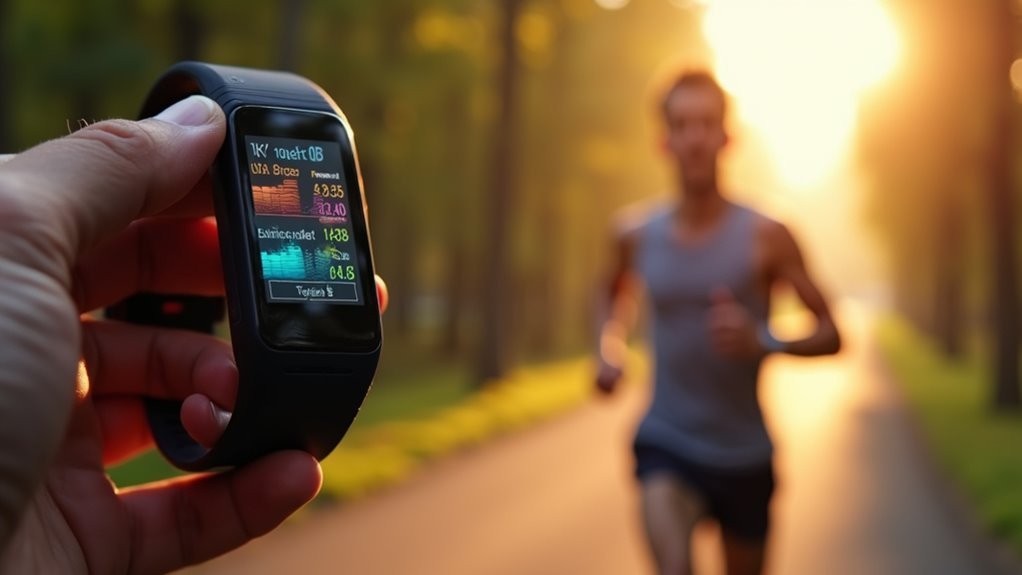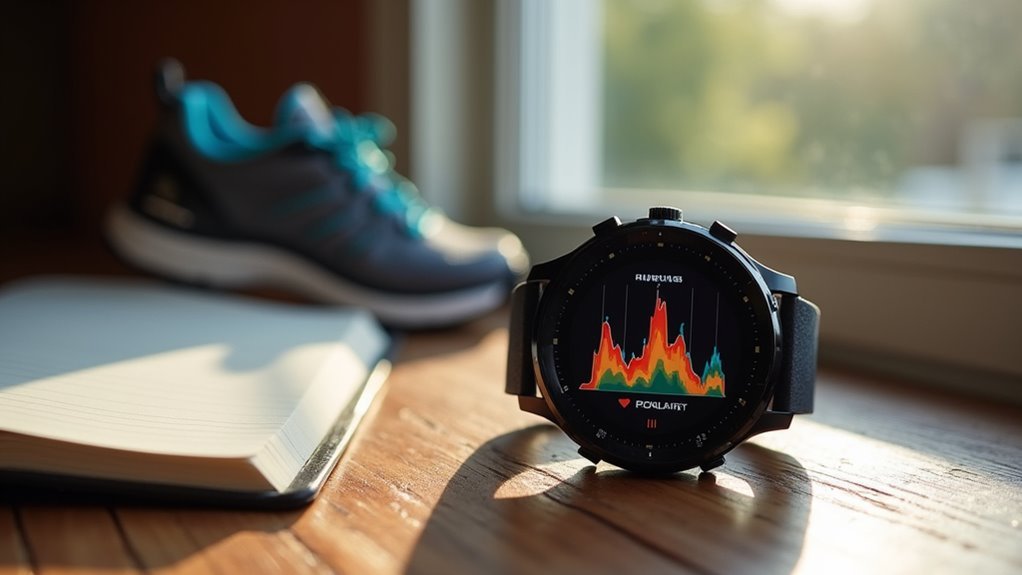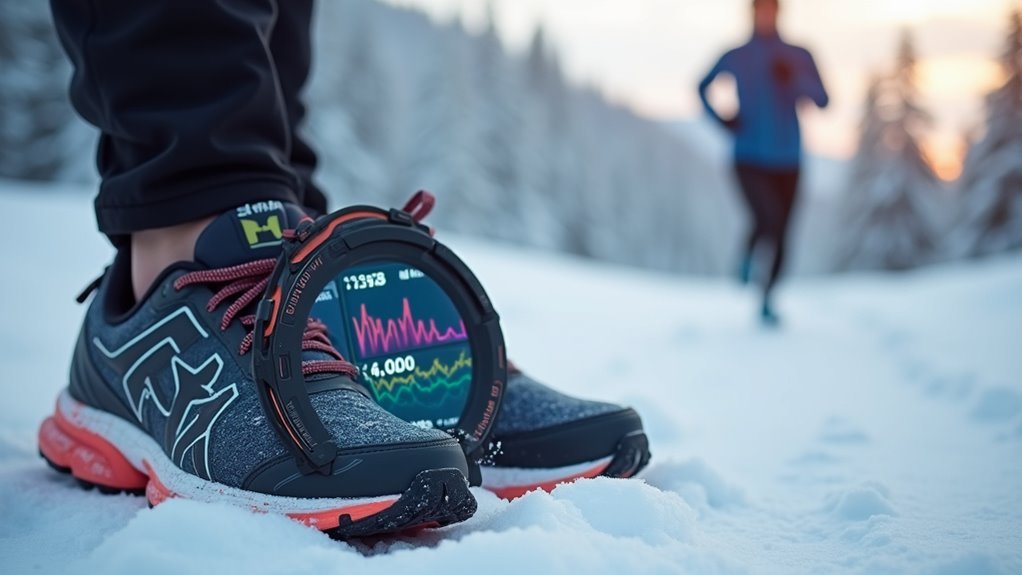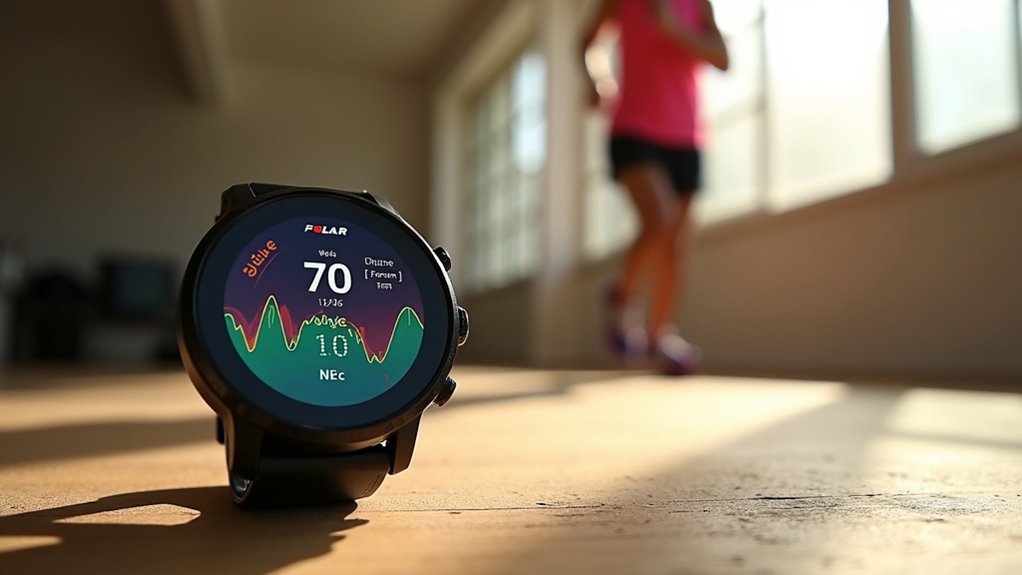Your Polar Running Index translates your heart rate and running speed into a single score that correlates with your VO2max and aerobic fitness. Higher scores indicate better running efficiency, while trends over weeks reveal your training progress more accurately than daily fluctuations. You’ll need runs over 12 minutes at speeds above 6 km/h for valid measurements. Rising scores suggest you can increase training intensity, while declining scores indicate you need more recovery. Understanding these patterns helps optimize your training decisions.
What Your Running Index Score Actually Means

When you see your Running Index score on your Polar device, you’re looking at a sophisticated measure of your running performance that combines heart rate and speed data from your workouts.
This score reflects your maximal aerobic running performance and reveals how efficiently you’re running – fundamentally showing how fast you can go with minimal effort.
Higher scores indicate better running efficiency, meaning you’re able to maintain faster paces while keeping your heart rate relatively low.
Your device calculates this score using data from runs lasting over 12 minutes at speeds above 6 km/h. The calculation also accounts for terrain effects, as running uphill creates more physiological stress while downhill running requires less effort.
The Running Index fundamentally translates the relationship between your heart rate and pace into a single number that represents your current running fitness level and performance capability.
Understanding the VO2max Connection
Why does your Running Index matter beyond just tracking your pace and heart rate? It’s directly connected to your VO2max, the gold standard for measuring aerobic fitness.
Your Running Index fundamentally estimates your VO2max by analyzing the linear relationship between your heart rate and oxygen consumption during runs.
When you’re running at submaximal speeds, your device calculates how efficiently your body uses oxygen based on your heart rate response. This gives you a reliable indicator of your aerobic capacity without requiring expensive lab testing.
As your training improves your VO2max, you’ll see corresponding changes in your Running Index score.
This connection makes your Running Index a powerful tool for predicting race performance, comparing fitness levels, and tracking meaningful improvements in your aerobic capacity over time. Since you receive a score after every run, you can monitor these performance changes consistently and make data-driven adjustments to your training plan.
Baseline Requirements for Accurate Measurements

To get reliable Running Index readings, you’ll need to meet specific baseline requirements that guarantee your Polar device can accurately calculate your performance metrics.
Your running sessions must last at least 12 minutes while maintaining speeds above 6 km/h, and your heart rate monitor must continuously record data above 40% of your maximum heart rate throughout the entire workout.
Additionally, you’ll need GPS-enabled tracking or a compatible stride sensor to capture precise speed and distance measurements that feed into the Running Index algorithm. If using a stride sensor, ensure it’s properly calibrated before your training sessions to maintain measurement accuracy.
Minimum Activity Duration Requirements
Before your Polar device can generate a meaningful Running Index score, your activity must meet specific baseline requirements that confirm accurate physiological measurements.
You’ll need to maintain continuous running for at least 12 minutes to produce reliable data. This minimum duration confirms your device captures relevant physiological responses and steady-state aerobic effort necessary for accurate calculations.
Activities shorter than 12 minutes won’t provide sufficient data for meaningful analysis. The extended timeframe allows your cardiovascular system to reach equilibrium, enabling consistent measurements of your running efficiency.
Your Polar device uses this duration threshold to filter out brief, irregular efforts that could skew results. Meeting this requirement confirms you’re getting Running Index scores that truly reflect your aerobic fitness level.
Additionally, your running speed must reach at least 6 km/h throughout the session, as slower movements don’t provide the metabolic intensity needed for accurate Running Index calculations.
Heart Rate Data Prerequisites
Since your Polar device relies on heart rate data to calculate Running Index scores, you’ll need accurate maximum and resting heart rate values stored in your device settings.
These baseline measurements are essential because your device calculates heart rate reserve—the difference between your HRmax and HRrest—which directly impacts Running Index accuracy.
You must guarantee continuous heart rate monitoring throughout your running session, as the device needs this data to estimate your VO2max and assess running economy.
Your heart rate should exceed 40% of your maximum heart rate for the calculation to begin.
Without properly calibrated heart rate monitoring and accurate baseline values, your Running Index scores won’t reflect your true aerobic fitness level or running performance improvements over time. For meaningful analysis, you can compare your results using the classification chart that provides age and gender-specific fitness norms.
Speed and GPS Accuracy
While heart rate data forms the foundation of Running Index calculations, your device’s ability to accurately measure speed and distance through GPS tracking is equally critical for reliable results.
You’ll need to maintain at least 6 km/h (3.75 mi/h) for valid measurements, as slower speeds don’t provide sufficient exercise intensity for accurate readings.
Environmental factors like tall buildings, dense forests, or tunnels can degrade GPS accuracy and distort your Running Index output.
GPS signal loss causes inconsistent distance readings, especially during terrain changes or intervals.
Choose devices with high-quality GPS receivers and frequent signal updates to minimize inaccuracies.
Your device uses GPS pace to calculate instantaneous speed, so any errors in speed measurement directly affect your Running Index quality and reliability. Consistent daily monitoring of these speed measurements enables you to identify patterns and optimize your Running Index accuracy over time.
Heart Rate Data and Its Impact on Your Score

Your Polar Running Index relies heavily on the quality and accuracy of your heart rate data, which serves as the primary indicator of your cardiovascular effort during runs.
Your device automatically collects this data when heart rate monitoring is active, but only runs exceeding 12 minutes and 6 km/h qualify for analysis.
Your score improves when your heart rate decreases at consistent paces, indicating better fitness. Conversely, higher heart rates at the same speeds suggest declining conditioning.
Your device calculates heart rate reserve (max minus resting HR) to estimate VO2max and predict performance.
Environmental factors like heat can artificially elevate your heart rate, potentially skewing scores. This index serves as a simpler alternative to expensive lab testing while providing similar insights into your fitness progression.
Verify your monitor fits snugly to maintain continuous readings, as gaps in data compromise accuracy and score reliability.
Pace Factors That Influence Your Running Index
Your running pace directly impacts how accurately Polar calculates your Running Index, with consistent speeds producing the most reliable scores.
When you maintain steady effort throughout your run, the device can better match your heart rate to your pace, creating a clearer picture of your aerobic fitness. The Running Index combines heart rate data, pace, resting heart rate, and max heart rate to provide a comprehensive assessment of your performance.
However, if you’re running below 6 km/h or frequently changing speeds, you’ll likely see distorted index values that don’t reflect your true performance capacity.
Consistent Pace Builds Accuracy
Because your Polar Running Index relies on the relationship between heart rate and pace to calculate aerobic fitness, maintaining consistent pace throughout your run greatly improves the accuracy of your score.
Consistent pace reduces signal noise from acceleration and deceleration, making your heart rate data more interpretable for the device’s algorithms.
When you maintain steady effort, you’re isolating fitness improvements rather than temporary environmental factors. Sudden pace changes introduce measurement errors that can skew your results, even though Polar devices use advanced filtering to smooth out fluctuations.
To maximize accuracy, plan runs on flat terrain and use pace alerts to stay within target ranges. Monitor real-time feedback and adjust your effort accordingly. Environmental conditions like running surface, wind, and temperature can significantly impact your Running Index measurements, so tracking these external factors helps you better understand variations in your scores.
This stability reduces variability in data points, leading to more reliable VO₂max estimates.
Speed Variability Affects Scores
While consistent pacing improves Running Index accuracy, various factors can disrupt your speed and skew your scores even when you’re trying to maintain steady effort.
Environmental conditions like heat, altitude, and headwinds increase your heart rate at the same pace, lowering your Running Index despite unchanged fitness. Terrain variations and running surfaces affect your economy and pace consistency, creating score fluctuations.
Internal factors also matter considerably. Your hydration status, fatigue level, and psychological state all influence heart rate responses.
Poor device calibration can record inconsistent speed data, while uncomfortable footwear or gear disrupts your natural rhythm. These speed fluctuations weaken the heart rate-pace relationship that drives the algorithm, making your scores less reliable indicators of actual fitness changes.
Minimum Pace Requirements Matter
Although your Polar device continuously tracks movement data, the Running Index algorithm requires specific minimum thresholds to generate valid scores.
You must maintain at least 6 km/h (3.75 mi/h) throughout most of your run for the calculation to work properly. This speed requirement guarantees your physiological data reflects actual running effort rather than walking or jogging.
Your run must also last at least 12 minutes to provide sufficient data for accurate analysis. Brief pauses at traffic lights won’t invalidate your session, but too many interruptions will.
The algorithm needs sustained pace data to properly correlate your heart rate with your running speed. Consistency in monitoring can lead to improved training outcomes when you track these metrics over extended periods.
When you consistently meet these minimum requirements, you’ll get more reliable Running Index scores that accurately reflect your fitness improvements over time.
Age and Gender Benchmarks for Comparison
Understanding where your Polar Running Index stands compared to others requires age and gender-specific benchmarks that reflect natural physiological differences across demographics. Your Running Index automatically calculates after each run, providing frequent assessment opportunities against established thresholds.
The benchmarks divide age groups into categories like 20–24, 25–29, 30–34, and 35–39 years, with thresholds dropping for each older group to reflect expected declines in aerobic capacity.
| Age Group | Good | Very Good | Elite |
|---|---|---|---|
| 20–24 | 51–56 | 57–62 | > 62 |
| 25–29 | 49–53 | 54–59 | > 59 |
| 30–34 | 46–51 | 52–56 | > 56 |
| 35–39 | 44–48 | 49–54 | > 54 |
You’ll notice older runners need lower scores for equivalent classifications, acknowledging that aerobic capacity naturally declines with age. These benchmarks also allow you to identify if you perform above or below average for your specific age group.
Tracking Progress Over Multiple Training Sessions
Since your Polar Running Index calculates automatically after each qualifying run, you’ll accumulate a wealth of data points that reveal meaningful patterns when viewed collectively rather than individually.
Your daily readings will fluctuate due to environmental conditions, equipment changes, hydration levels, and training fatigue. Don’t focus on single sessions—instead, look for consistent trends over weeks and months through Polar Flow’s chronological timeline.
Daily fluctuations are normal—focus on consistent trends over weeks and months rather than individual training sessions.
Here’s how to effectively monitor your progress:
- Review weighted averages over four-week periods, with recent weeks carrying more significance.
- Analyze graphical reports to identify upward, downward, or plateau trends.
- Maintain consistent training to generate reliable data for meaningful comparisons.
- Focus on long-term signals rather than day-to-day variations that reflect temporary conditions.
This approach reveals true aerobic development patterns and helps you establish realistic race goals based on your current fitness trajectory.
Identifying Performance Improvements and Plateaus
When you’ve been tracking your Running Index consistently, distinguishing between genuine improvements and temporary fluctuations becomes essential for understanding your aerobic development.
True performance gains show up when you’re running at the same pace with less effort, or maintaining the same exertion while moving faster. You’ll see consistently increasing scores across multiple runs, indicating positive adaptation.
However, stagnant or declining scores over several weeks signal potential plateaus. If you notice no observable changes in speed or effort despite consistent training, it’s time to evaluate. Keep in mind that the Running Index may penalize hard runs disproportionately, potentially making race performances appear worse than they actually are.
Rule out environmental factors like terrain, weather, or altitude changes first. When plateaus persist, consider incorporating training variety, adjusting intensity, or implementing recovery strategies to restart your progress.
Setting Realistic Race Goals Using Your Index
Your Running Index provides a reliable foundation for setting race goals that match your current fitness level rather than wishful thinking.
You can use this score to calculate realistic target times for different race distances, giving you concrete numbers to work toward in your training. The improvements translate directly into performance gains – for example, changes in running efficiency can mean the difference between a 4:02 vs. 3:40 marathon finish time.
As your index improves over time, you’ll need to adjust these goals upward to continue challenging yourself and maximizing your potential.
Understanding Your Current Fitness
Before you can set meaningful race goals, you’ll need to understand what your Polar Running Index actually tells you about your current fitness level. This metric estimates your maximal aerobic running performance by combining data on your aerobic fitness and running economy.
Your Running Index provides valuable insights through:
- VO2max estimation – Shows your body’s maximum oxygen consumption capacity during exercise
- Running efficiency analysis – Reveals how economically you’re using energy while running
- Performance comparison – Allows you to measure your fitness against age and gender norms
- Training status indicator – Reflects whether your current fitness is improving or declining
For accurate readings, verify your heart rate monitor and GPS are properly calibrated, and remember that environmental factors like heat and terrain can influence your scores.
Calculating Target Race Times
Once you’ve established your current Running Index through several consistent training sessions, you can transform this number into actionable race goals using Polar’s reference tables.
Your index directly correlates to predicted finishing times across standard race distances. For example, an index of 40 suggests you’re capable of running a 5K in 32:20, a 10K in 1:07:00, or a half marathon in 2:29:30.
Don’t rely on a single run’s index for goal-setting. Instead, use multiple recent sessions to establish a stable baseline. Remember that external factors like running surface, wind conditions, and temperature can influence your Running Index values, so consider these variables when setting your race targets.
Focus on the specific distance you’re training for, and adjust your targets as your index improves over time.
Adjusting Goals Over Time
Setting initial race targets marks just the beginning of your goal-setting journey. Your Polar Running Index will evolve as your fitness improves, requiring regular goal adjustments to maintain realistic expectations and continued progress.
Here’s how to effectively adjust your goals over time:
- Monitor trends over four-week periods – Focus on the last two weeks’ data while considering longer-term patterns in your Running Index changes.
- Make incremental improvements – Avoid drastic goal changes; instead, aim for gradual progression that matches your fitness development.
- Shift focus to pace-based targets – Rather than fixating on specific finish times, concentrate on maintaining sustainable paces that align with your current index.
- Create feedback loops – Use your Running Index as continuous feedback to refine training intensity and adjust upcoming race goals accordingly. Remember to review your progress regularly to determine if goals need modification when improvement plateaus.
Common Factors That Can Skew Your Results
While your Polar Running Index provides valuable insights into your aerobic fitness, several factors can skew these results and lead to misleading scores.
Environmental conditions like hills, altitude, extreme temperatures, and strong winds greatly impact your heart rate and performance data. Your internal state matters too—poor sleep, dehydration, stress, or illness can artificially elevate heart rates and lower scores.
Equipment issues create additional problems. Incorrectly calibrated stride sensors produce inaccurate speed measurements, while poorly fitting heart rate monitors give unreliable data. Heavy clothing or wrong shoe types also affect your natural running efficiency.
High-intensity, short-duration runs often receive penalties in Polar’s scoring system, making them less reliable for evaluating aerobic capacity.
You’ll get more accurate readings from consistent, moderate-effort runs in familiar conditions.
Optimizing Training Intensity Based on Your Score
Now that you understand what can throw off your readings, you can use clean, reliable Polar Running Index data to fine-tune your training intensity for maximum performance gains.
Your Running Index trends reveal vital insights about your aerobic development and training effectiveness.
Here’s how to optimize your intensity based on your scores:
- Rising scores – You’re adapting well to current training loads and can gradually increase intensity or volume.
- Plateauing scores – Maintain current intensity while focusing on consistency and running economy improvements.
- Declining scores – Reduce intensity immediately and prioritize recovery to prevent overtraining.
- Fluctuating scores – Evaluate external factors like sleep, nutrition, and stress before making training adjustments.
Using Polar Flow Data for Long-term Analysis
Once you’ve gathered several weeks of consistent Running Index data, Polar Flow’s analytical tools transform individual measurements into powerful insights about your fitness trajectory.
The platform’s weighted average system emphasizes your last two weeks while incorporating four weeks of data, giving you accurate trend analysis that’s more reliable than daily fluctuations.
You’ll find detailed reports that visualize your Running Index trends alongside performance predictions for common race distances.
These forecasts become increasingly accurate as your data accumulates under similar conditions. The Running Index calculation relies on both heart rate data and speed measurements to provide the most accurate assessment of your running efficiency.
The platform lets you compare your progress against age and gender normative charts, contextualizing your fitness relative to peers.
Integrating Running Index With Other Performance Metrics
Although your Running Index provides valuable standalone insights, combining it with complementary performance metrics creates an extensive fitness assessment that reveals patterns invisible to any single measurement.
This thorough approach maximizes your training effectiveness and performance understanding.
Here’s how to integrate your Running Index with other key metrics:
- Lactate Threshold Data – Combine with Running Index to understand both aerobic capacity and metabolic efficiency
- Resting Heart Rate Trends – Track alongside Running Index changes to monitor overall cardiovascular improvements
- Race Performance Times – Use Running Index to predict finish times and validate actual race results
- Training Load Metrics – Balance Running Index improvements with recovery data to prevent overtraining
Your Running Index fundamentally estimates VO2max, reflecting how efficiently you utilize oxygen during exercise.
When you’re tracking multiple metrics simultaneously, you’ll spot fitness improvements faster and make smarter training decisions.
Frequently Asked Questions
Can I Manually Reset My Running Index if I Think It’s Inaccurate?
You can’t manually reset your Running Index since Polar devices don’t offer that option. Instead, check your max and resting heart rate settings in Polar Flow, as incorrect values often cause inaccurate readings.
Does Altitude Training Affect My Running Index Calculations and Scores?
Altitude training affects your running index by changing your heart rate and oxygen efficiency. You’ll see improved scores as cardiovascular adaptations develop, though initial readings may fluctuate during acclimatization periods.
How Often Should I Expect to See Changes in My Running Index?
You’ll see Running Index changes after each GPS and heart rate enabled run, but don’t expect meaningful fitness trends until you’ve consistently trained for weeks or months.
Will Running on a Treadmill Give Me the Same Accurate Running Index?
Treadmill running won’t give you the same accurate Running Index. You’ll miss wind resistance, terrain changes, and distance measurement differences that affect heart rate and speed data accuracy for proper calculations.
Can Injury Recovery Periods Cause Temporary Drops in My Running Index?
Yes, injury recovery periods can cause temporary drops in your running index. Reduced training intensity and volume during recovery affect performance metrics, but you’ll see improvements return as you gradually increase training intensity.
In Summary
You’ve learned how to decode your Polar running index and use it effectively. Don’t obsess over daily fluctuations—instead, focus on long-term trends that reveal your true fitness progression. Remember that external factors can temporarily skew your numbers, so you’ll get the most accurate picture by tracking consistently over weeks and months. Use this data alongside other metrics to fine-tune your training and maximize your running performance.





Leave a Reply